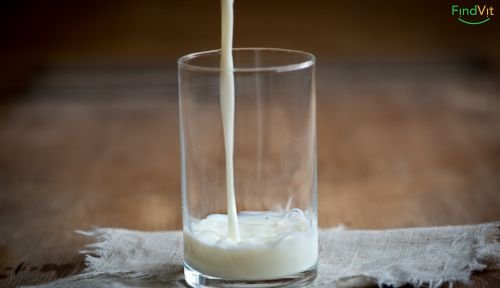Milk has been a part of our diet for a long time, but more and more often the question arises: is milk healthy? Derived from cows, goats or other animals, this drink is a rich source of nutrients. However, more and more alternatives have recently appeared, such as coconut milk, almond milk or soy milk. These changes encourage people to reassess the place of milk in their daily diet.1
In this article, we will examine the latest research information on the health effects of milk. We will discuss the nutritional value of milk, its benefits for different age groups, including milk consumption for children. We'll also look at the potential downsides of milk consumption and see if lactose-free milk can be a healthy alternative. Finally, based on expert opinion, we will present conclusions about the role of dairy products in a balanced diet.

Nutritional value of milk
Milk is a complex and valuable food substance, which is rich in various components necessary for the body. It consists of water and solids, which give milk its unique properties and nutritional value.
Main nutrients in milk
Milk contains three main nutrients: protein, fat and carbohydrates. Proteins make up 2-5.5% of milk and are a valuable source of complete amino acids. After drinking one glass of milk, a person receives about 11% of the required daily protein rate. Milk proteins are divided into casein and whey proteins, the latter being particularly valuable due to their high content of sulphur-containing amino acids.
Fat plays an important role in milk, although the amount can vary depending on the type of milk. About 140 different fatty acids are found in milk fat, the most important of which are saturated (eg palmitic, stearic) and unsaturated (eg oleic, linoleic) acids. Fat not only provides energy, but also helps in the absorption of fat-soluble vitamins A, D, E and K.
The main source of carbohydrates in milk is lactose, which ranges from 4.5 to 5.2 g/100 g. Although lactose is a sugar, it does not give milk its sweet taste, but is important in the fermentation of dairy products.
Vitamin and mineral content
Milk is an excellent source of vitamins and minerals. Almost all vitamins are found in it, although some are in relatively small amounts. It is especially valuable vitamin B12, whose glass of milk provides 20% necessary daily rates. Milk also contains vitamins B1, B6, C and A.
Milk is particularly rich in minerals calcium, phosphorus and magnesium. A glass of milk can provide up to 20% of the necessary daily calcium rate, which is especially important for the health of bones and teeth. Phosphorus and magnesium are involved in important body processes, including metabolism and protein synthesis. In addition, milk contains potassium, zinc, selenium and iron.
Milk fat composition
The composition of milk fat is complex and varied. They consist of triacylglycerols (98-99%) and a small amount of phospholipids. The fatty acid composition of milk can vary depending on the way the cows are fed. Studies show that milk from pastured cows is slightly higher in polyunsaturated fatty acids compared to barn-fed cows.
It is important to mention that milk fat composition can be changed by optimizing cow feeding. For example, milk from pasture-raised cows contains more polyunsaturated fatty acids beneficial to the human body, which are important for the prevention of cardiovascular diseases.

Interesting facts about milk
Milk is one of the most important foods in human history. It is not only nutritious, but also has various interesting properties. Let's look at some interesting facts about different types of milk.
Cow's milk
Cow's milk is a versatile and complete product that contains about 200 different substances and chemical compounds. Its composition is balanced according to essential nutrients. Interestingly, the color of milk depends on proteins, especially casein, and carotene gives the yellowish shade. The taste of milk is sweet because of the carbohydrate lactose in it.
The density of cow's milk is 1027-1032 kg/m3, and the freezing point ranges from -0.52 to -0.58°C. These indicators can help determine the quality and naturalness of milk. For example, adding 10% of water reduces the density of milk by 3 kg/m3.
Soy milk
Soy milk is a popular alternative for those who refuse animal products. Interestingly, soy is one of the few plant products that contains all the essential amino acids. However, it is important to know that soy is high in Omega 6 fatty acids and low in Omega 3, which can cause inflammatory processes in the body.
Soy milk contains a lot of phytoestrogens, which can be beneficial for women during menopause, but too much consumption can also have negative consequences.
Almond milk
Almond milk is lactose free and suitable for those with milk sensitivities or allergies. It is a good source of vitamin E, which is important for healthy skin and vision. Almond milk is low in calories and fat, making it suitable for those watching their weight.
Interestingly, almond milk can be easily made at home by controlling the ingredients and taste. However, it is important to know that store-bought almond milk often contains only 2% of almonds themselves.
Coconut milk
Coconut milk is popular in Caribbean, South American, Indian and Hawaiian cuisines. It is rich in vitamins and minerals, including vitamin C, iron, magnesium and potassium. Coconut milk is high in healthy saturated fats, including medium-chain triglycerides (MCTs), which can boost your metabolism.
Interestingly, coconut milk has been used in traditional medicine for centuries for its moisturizing and anti-inflammatory properties.
Goat's milk
Goat's milk is easier to digest than cow's milk and is suitable for those who are allergic to cow's milk. It contains more vitamins, calcium and phosphorus than cow's milk. Interestingly, goat's milk is digested five times faster than cow's milk.
Goat's milk has an alkaline reaction, so it is suitable for people with increased acidity of gastric juice. In folk medicine, goat's milk is considered to have even magical powers to help treat various diseases.

Research Review
The latest research on the benefits of milk
Research conducted in recent years has revealed interesting facts about the effects of milk on the human body. In 2018, researchers at the University of Texas found that milk fat is not only harmless, but can even reduce the risk of stroke. The study looked at more than 3,000 people over the age of 65. The results showed that one of the fatty acids in milk reduces the risk of dying from a stroke by as much as 42 percent.
Another important study conducted in Ireland revealed that milk from cows that graze on natural pastures has more Omega 3 fatty acids, linoleic acid and protein. These results highlight the importance of animal rearing conditions for milk quality.
Conflicting research results
While some studies show the positive effects of milk, others reveal potential risks. A Harvard University study showed that men who drank two or more glasses of milk a day were twice as likely to develop prostate cancer. Additionally, some studies have linked high dairy consumption to an increased risk of ovarian cancer in women.
On the other hand, studies show that dairy products can reduce the risk of colon, bladder, breast, and stomach cancer. Calcium consumed with dairy products is believed to be involved in these processes.
Recommendations for milk consumption
Despite the conflicting results, experts still recommend including milk and its products in the daily diet. Adults are recommended to consume 1-2 portions of dairy products per day, and children - even 3 portions. One portion can be a glass of milk, a container of yogurt or a similar portion of other dairy products.
It is important to choose leaner dairy products without added sugar. Sour milk products are especially valuable due to their probiotic properties. They can reduce the risk of diabetes and improve glucose control.
Finally, it should be mentioned that dairy products are not necessary for everyone. People who are lactose intolerant or have other health problems can choose alternative sources of calcium and protein, such as green leafy vegetables and nuts.

Milk consumption in different age groups
Milk for babies and children
Mother's milk is the best food for babies. However, children from the age of one can already be given cow's milk, but not more than half a liter per day. From the age of three, the amount of milk can be increased. It is important to mention that undiluted cow's milk is not recommended for infants and young children for several reasons. First of all, cow's milk contains too much protein, which can cause allergies or impair kidney function. In addition, cow's milk lacks iron, which can cause anemia.
Fermented milk products such as yogurt, kefir and cottage cheese are easier to digest and can be included in a child's diet earlier. You can start giving yogurt and cottage cheese from 10 months, and sour milk and cheese - from one year. Yoghurt is especially good because it contains a lot of calcium and good bacteria that help absorb it.
The need for milk in adolescents
During adolescence, dairy products become especially important due to intensive growth and bone formation. Calcium, which is abundant in milk, is essential for strong bones and teeth. Adolescents are recommended to consume 1000-1200 mg of calcium per day, which corresponds to 3-4 servings of dairy products.
It is important to note that the body undergoes many changes during adolescence, so parents should help children accept these changes and form a healthy attitude towards their bodies. This may include developing good eating habits, including regular consumption of dairy products.
Adult milk consumption
Adults are recommended to consume 1-2 servings of dairy products per day. It can be a glass of milk, a container of yogurt or a similar portion of other dairy products. It is important to choose leaner dairy products without added sugar. Sour milk products are especially valuable due to their probiotic properties.
Dairy products are important not only for calcium, but also for other valuable nutrients such as protein, vitamin D and potassium. However, it is important to mention that dairy products are not necessary for everyone. People who are lactose intolerant or have other health problems can choose alternative sources of calcium and protein.
Milk in old age
In old age, dairy products remain important for their beneficial effects on bone health. However, after the age of 65, the amount of the enzyme lactase in the body may decrease, so signs of milk intolerance may appear. In this case, it is recommended to choose fermented milk products such as kefir, sour milk or cottage cheese, which are easier to digest.
Getting enough calcium and vitamin D is especially important as you get older, which help maintain strong bones and reduce the risk of osteoporosis. The recommended amount of calcium for older people is 1200-1500 mg per day. In addition to dairy products, calcium can also be obtained from green leafy vegetables and nuts.

Health benefits of milk
Milk is a valuable food product that has many beneficial properties for the human body. It is rich in various nutrients that play an important role in maintaining overall health.
Strengthening bones and teeth
Milk is an excellent source of calcium, which is essential for strong bones and teeth. Calcium not only strengthens the gums, but also protects the outer side of tooth enamel, helping to prevent tooth decay. In addition, the phosphorus in milk helps the body absorb and use calcium, and also strengthens teeth by restoring their enamel. These minerals also help maintain functional jawbones.
Muscle growth and recovery
Dairy products are rich in proteins, which are important for maintaining good skin, hair, nails and muscles. Protein also helps you feel fuller for longer and reduces the likelihood of overeating episodes. Fermented dairy products such as yogurt, kefir or sour milk are rich in probiotics, which ensure smooth digestion and support healthy gut microflora and strong immunity.
Cardiovascular health
Despite previous beliefs, recent research suggests that dairy fat may be beneficial for cardiovascular health. A study conducted by Texas scientists revealed that milk fat is not only harmless, but can even reduce the risk of stroke. In addition, the minerals in milk, such as potassium and magnesium, are important for the functioning of the cardiovascular system.
It is important to mention that milk contains many other useful substances, including vitamins D and B12, which are involved in various processes in the body. One cup 3.2 percent. full-fat milk provides 149 kcal, 7.7 g of protein and 8 g of fat. However, it is important to choose unprocessed dairy products, as they contain more beneficial substances than processed, concentrated products.

Possible disadvantages of milk consumption
Lactose intolerance
Lactose intolerance is a common problem faced by many people. It is a condition in which the body does not produce enough of the enzyme lactase needed to break down lactose (milk sugar). This disorder presents with a variety of unpleasant symptoms such as bloating, pain, diarrhea and gas. These symptoms usually occur within 30 minutes to 2 hours after consuming milk or milk products.
Interestingly, lactose intolerance is more common in adults than in children. In children under 5 years of age, this problem is quite rare. However, people generally produce less lactase as they age, and nearly 70% adults worldwide have this problem.
Allergy to milk proteins
Allergy to milk proteins is another common problem, especially among infants and young children. This allergy is caused by an immune system reaction to one or more proteins in milk, usually casein and beta-lactoglobulin. Allergy symptoms can range from mild skin reactions to serious indigestion or even anaphylaxis.
It is important to note that milk allergy and lactose intolerance are not the same, although their symptoms may be similar. Milk allergy is more common in children and often goes away with age. However, in some people, this allergy persists into adulthood.
Residues of hormones and antibiotics
Another potential disadvantage of milk consumption is the presence of hormone and antibiotic residues in milk. Antibiotics used to treat cows can get into the milk and cause problems for consumers. Antibiotics in milk can interfere with the production of sour milk products, reduce their quality and even contribute to the emergence of antibiotic-resistant bacteria.
It is important to know that antibiotics are excreted from the cow's body with milk 2-3 days after treatment. Therefore, such milk should be collected separately and should not be used for food production. Although pasteurization of milk slightly reduces the activity of antibiotics, it does not completely eliminate them.
In order to avoid these problems, it is important to apply strict control measures at all stages of milk production, from the treatment of the cows to the milk processing plants. It is also important that consumers are informed about the possible disadvantages of milk consumption and can make informed decisions about their diet.

FAQ (Frequently Asked Questions) Part - "Is milk healthy?"
What is milk and what is its composition?
Milk is an animal product rich in protein, calcium, vitamin D and other essential nutrients that are important for bone health and overall health.
What are the health benefits of milk?
Milk is an excellent source of calcium, which is needed for strong bones and teeth. In addition, the proteins contained in it help maintain muscle mass and support the normal functioning of the immune system.
Are there people for whom milk may not be recommended?
yes, dairy products can cause digestive problems in people with lactose intolerance. In addition, some individuals may experience allergic reactions to milk proteins.
How does milk affect children's health?
For children, milk is important during the growth and development stage, as it provides essential food components such as calcium and protein, which are important for the correct development of bones and muscles.
Does milk have negative health effects?
Although milk is good for many people, in some cases it can contribute to certain health problems, for example, its fat content can raise blood cholesterol levels.

Conclusion
Milk remains a significant part of food products, influencing various areas of health. The proteins, minerals and vitamins it contains contribute to bone strength, muscle growth and heart health. However, it is important to consider individual needs and possible restrictions, such as lactose intolerance or milk protein allergy, when choosing dairy products in your diet.
Finally, milk consumption should be balanced and adapted to different age groups. For children and adolescents, milk is especially important for growth and development, and for adults and older people, it can help maintain general health. Despite some conflicting research results, experts still recommend including milk and its products in the daily diet, taking into account personal needs and health status.











